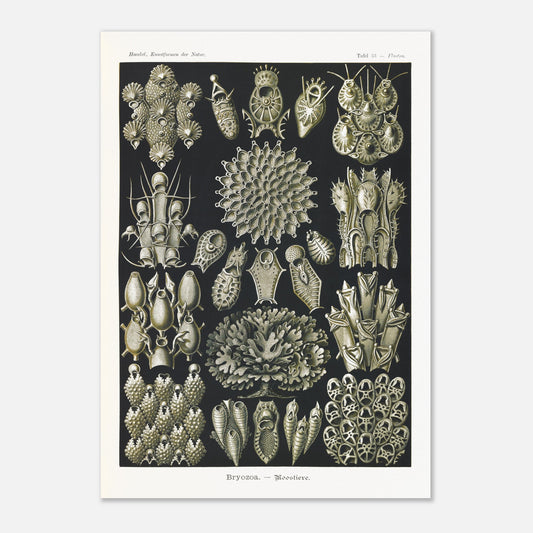Bryozoans - Decorative encyclopedic plate - Ernst Haeckel, Kunstformen der Natur
Bryozoans - Decorative encyclopedic plate - Ernst Haeckel, Kunstformen der Natur
Couldn't load pickup availability
Engraving reproduction of: Bryozoa
Original title Bryozoa - Moostierre
Poster of Flustra - Worms of the class Bryozoa or Bryozoa (Legion of annelids or stolmatopods)
Illustration from the book Kunstformen der Natur, which is a collection of artistic lithographs of natural sciences published by the German biologist Ernst Haeckel between 1899 and 1904.
This naturalistic illustration is part of an overall style inspired by Ernst Haeckel, which greatly influenced the emerging Art Nouveau movement at the beginning of the 20th century. This work, illustrating the impressive beauty and great diversity of the biological world, was complemented by a certain amount of scientific information, some excerpts of which are reproduced below.
This information is over 120 years old and some of it may be outdated!
Scientific classification:
Phylum of Vermiform Animals (Vermalia) Main class of Mouthworms (Prosopygia) Class of Moss Animals (Bryozoa) Subclass Stelmatopoda (Stelmatopoda) Order Cheilostomata (Cheilostomata)
Scientific notice (extract) accompanying the poster print of Bryozoa - Bryozoa :
The figures in this plate represent, at high magnification, the delicate chambers of bryozoa. The small living animals themselves, which build and inhabit these solid, calcified chambers, are not shown here, but are in Plate 23 (Cristatella). Their size is only one or a few millimeters, many are even smaller. While the delicate vermidians of this form-rich class almost always have the same polyp-like form (Pl. 23, Fig. 6), the shape of the calcareous chambers or shells they produce is extremely varied; about 3000 species are distinguished, of which about one-third are living and two-thirds are extinct and fossilized. The majority of species live in the sea, very few in fresh water. Almost all bryozoa live in colonies, with many individuals (or people) being united in a colony or corm. All individuals in a colony are directly connected and have a common diet, similar to individuals in polyp colonies. Each individual forms a horny or calcareous lodge, a chamber (or "cell"), into which it can withdraw. The numerous chambers (often several thousand in a colony) are sometimes arranged side by side in a plane, sometimes aligned in a chain; in the former case, the colonies have the form of leaves or crusts, which grow either freely (Fig. 16), or by covering like bark stones, marine plants and other objects (Fig. 7); in the latter case, the colonies usually form delicate shrubs or bushes, often richly branched. In many bryozoans, the individuals of the colony often assume very different forms by division of labor (as in polyps and siphonophores); Thus, among fully developed and sexually mature individuals, other individuals are often found which have neither intestine nor sexual organs, but which act as organs of grasping and touching; they sometimes have the form of oscillating rods (vibracula) or bird heads with a movable lower mandible (avicularia, Figs. 6, 14 and 15).
Species present on the Bryozoa - Flustra naturalist board :
- Lepralia spinifera
- Cribrilina punctata
- Umbonula verrucosa
- Cribrilina radiata
- Lepralia alata
- Bugula flabellata
- Cupularia stellata
- Farciminaria aculeata
- Umbonula reticulata
- Cribrilina costata
- Smittia landsborovii
- Smittia reticulata
- Lepralia annulata
- Diachoris magellanica
- Diachoris crotali
- Flustra gayi
- Schizoporella hyalina
- Lepralia variolosa
- Chorizopora brongniartii
- Aragoi Flustra
About this print
About this print
The layout and composition of this reproduction have been the subject of our greatest attention.
- Respect for the format of the original work: in order to faithfully transcribe the artist's intention, the work is not cropped/re-cut except in extreme cases (obvious imperfection, geometry problem, etc.) in which case the cropping will be as light as possible.
- The presence of white margins is sometimes necessary in order to present the work in a balanced manner.
- Each size offered has been specifically composed, therefore, the size of the white margins may vary from one print size to another. Remember to check this detail carefully!
- Print only, frame not included!
Features
Features
- Premium 200gsm matte white paper, durable and strong.
- Natural, smooth uncoated finish, silky to the touch
- FSC certified paper or equivalent certifications depending on regional availability.
- Each print is shipped in sturdy packaging, ensuring safe transport.
- Each print is printed and shipped on demand. No minimum order quantity is required.
Share !









Recently viewed products
We are listening to you
If you are looking for a specific composition, a particular layout, or any other customization need, our team is at your disposal and will do everything possible to meet your requests.
So don't hesitate to...




